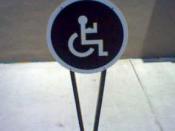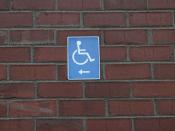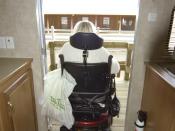Over the years, I have heard many, many times from my parents, my coaches and my
teachers to never take anything for granted. And even though I heard them, I'm not quite
sure that I was actually listening to the true meaning of these words. Not until you've actually
experienced 'walking in someone else's shoes' can you truly begin to
understand what taking things for granted means. And not necessarily the most obvious
things in one's life...like athletic ability or intelligence or opportunities...but the simplest things
such as reaching for a book, opening a door, climbing stairs, brushing one's teeth. The list is
endless really. This assignment made me realize just how difficult some of these simple tasks
are for many people in our society.
The first task of this assignment was to visit the library and sign out some books related to
disability. For most people this doesn't present any problems.
But for a wheelchair bound
person or one with limited mobility, there are huge obstacles to overcome. Personally I had
little trouble maneuvering from place to place. In a matter of
minutes, I was able to walk to the third floor, quickly look around
then return to the main floor where I asked for some assistance
locating the materials I needed. However for someone in a wheelchair,
this sequence of events would take much longer.
First of all, he/she would have to locate the key to the elevator
from someone. Upon arriving at the third floor, he/she would then have
to move through extremely narrow aisle ways that is barely wide enough
for the able bodied to walk through. Once their materials are located,
they will require the assistance of someone to actually get the books
from the shelves. This simple task took me approximately 20 minutes.
One can only begin to imagine how long this task would take someone
with a physical disability.
So what does the term disability actually mean? Disability can be
defined as a condition that prevents an individual's functional
limitations and impairs their performance and enjoyment of daily
activities. In other words easy tasks become very difficult to
complete and therefore they enjoy them even less.
There are two schools of thought associated with disability, the
traditional model and the social model.
It is important to understand the traditional attitudes towards
disability in order to plan program's for them that will improve
their quality of life so that they feel like important members of
society. "People with physical disabilities can enjoy many of the same
health-related benefits from resistance training program's as those
without physical disabilities"
Issues associated with disability need to be brought to the
attention of those responsible for making program's and policies. They
must know how much their decisions affect the lives of those living
with disability. "Before developing any individualized program's for a
client, the initial assessment should focus on evaluating these
conditions: range of motion, basic strength and muscle function". It is
important to realize that all of these factors differ from one disabled
person to another. So to put into effect one policy that covers all
will most likely only meet the needs of a few.
Traditionally society has also labeled those with disabilities as
'unfortunate'. We group them together according to their disability,
such as 'the blind' or 'the deaf'. Also many types of disabilities are
more acceptable than others. Those who are blind or deaf are definitely
seen in a different light than those who traditionally have been called
'retarded'. Expectations differ depending on the disability. "It is
generally appropriate to follow basic guidelines for resistance
training development when designing program's for clients with various
physical and mental disabilities."
The traditional model sees the cause of the problem as stemming from
limitations or losses that are assumed to arise from the disability.
Programming then must meet the individual needs of the client rather
than the group as a whole. The old saying 'one size fits all' does not
address the needs of those with disabilities. Individual assessments
are required to identify and develop personal program's to suit their
needs. Similar to athletes exercising at the gym, their workout
program targets certain muscle groups depending on the needs of the
athlete.
The social models of disability recognize that there are no
individual limitations of any kind for the disabled. These individuals
are very capable of completing most tasks if the appropriate services
and programs are available to them. Impairment does not mean the same
thing as disability.
The social model recognizes that people living with disabilities can
be valued members of the workforce and society. Unlike years ago when
"more formal institutions affiliated with religious organizations were
established but not all persons who needed help received it (for
example, during the 17th and 18th centuries, society incarcerated the
mentally ill), society today recognizes the importance of integrating
those living with mental illness into society. No longer are the
mentally ill sent away or jailed. Training and assistance is provided
to improve their quality of life. Group homes and job programmers are
available to meet their needs. In schools those with disabilities can
be found in the classroom working side by side with every other student
in the school.
My father tells me the story of a special needs student in his class.
At the end of the year his students went on a field trip to Muskoka
Woods for 4 days and 3 nights. Every night Matthew wet the bed. And
every night those staying in his bunk changed him and put him to bed.
In a tragic accident while vacationing in Germany he was killed along
with his father and younger brother. At the memorial service, my father
told Matthew's mother that Matthew had taught his other students more
about compassion and understanding than any lesson they could have
learned from a book.
There have also been huge advances in the health care field that
have enabled those living with disability to enjoy a better quality of
life. "Technology has helped to extend or improve the lives of
premature infants, people living with devastating illness, those
suffering from closed-head injuries and the elderly".
One of the areas that the social model has addressed is in the area
of funding. In order for society to look at those with disabilities as
contributing members of society, then money has to be available in
order to educate, train, provide health services and transportation for
the disabled. "Observing that the working disabled tended to fall into
the lowest socio-economic class, Ontario's social assistance review
committee declared that it would be unrealistic to withdraw financial
support from this group."
This assignment has opened my eyes in many ways. I am more aware of
the difficulties that every day living presents those living with
disability. I also recognize that change can only be brought about when
both schools of thought are working together. Disability issues are
really human rights issues. Every human being should be treated equally
and every human being should have every opportunity to enjoy life. We
should not ever take even the smallest things for granted. We need to
recognize the improvements in the quality of life offered to those
living with a disability but we must also recognize that these
improvements took a long time. And there is still much to be done. We
must also look at life from others' perspective as well. Where I saw
taking books from the library as a difficult task for a wheelchair
bound student, I must also applaud his/her determination and
perseverance at accomplishing his/her goal. I should not judge the
accomplishments by my standards but understand the accomplishments
from theirs.


